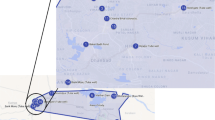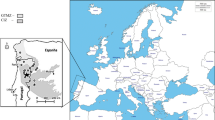Abstract
The activity concentrations of 238U and 234U have been determined in groundwater samples of hot springs and deep wells in Northern Greece. The analysis was performed by alpha spectroscopy after pre-concentration and separation of uranium by cation exchange (Chelex 100 resin) and finally its electro-deposition on stainless steel discs. The uranium concentration in deep wells and springs varies strongly between 0.15 and 7.66 μg L−1 and the corresponding 238U and 234U activity concentrations between 1.82–95.3 and 1.70–160.1 mBq L−1, respectively. The obtained isotopic ratio 234U/238U varies between 0.95 and 1.74 indicating a disturbed radioactive equilibrium between the two uranium isotopes. In the studied waters uranium concentrations in solution decrease with increasing pH in the pH range between 7 and 9. This is attributed to the fact that at lower pH dissolution of soil minerals occurs and uranium which is adsorbed or forms solid solution with the geological matrix enters the aqueous phase. The strong dependence of the uranium concentration in the studied waters from the dissolution of the geological matrix is corroborated by the strong correlation of the uranium concentration with the electrical conductivity measured in the ground waters under investigation.




Similar content being viewed by others
References
Porcelli D, Swarzenski PW (2003) The behavior of U- and Th-series nuclides in groundwater. Rev Mineral Geochem 52(1):317–361
Jobbagy V, Kavasi N, Somlai J, Dombovari P, Kardos R, Kovacs T (2010) Radioanalytical investigations of uranium concentrations in natural spring, mineral, spa and drinking waters in Hungary. J Radioan Nucl Chem 286(2):417–422
Chau ND, Michalec B (2009) Natural radioactivity in bottled natural spring, mineral and therapeutic waters in Poland. J Radioan Nucl Chem 279(1):121–129
de Camargo IMC, Mazzilli B (1996) Determination of uranium and thorium isotopes in mineral spring waters. J Radioan Nucl Chem 212(4):251–258
Killiari T, Pashalidis I (2010) Simplified alpha-spectroscopic analysis of uranium in natural waters after its separation by cation-exchange. Radiat Measurem 45(8):966–968
Pashalidis I, Tsertos H (2004) Radiometric determination of uranium in natural waters after enrichment and separation by cation-exchange and extraction techniques. J Radioan Nucl Chem 260:439–442
Kehagia K, Koukouliou V, Bratakos S, Seferlis S, Tzoumerkas F, Potiriadis C (2007) Radioactivity monitoring in drinking water of Attika, Greece. Desalination 213(1–3):98–103
Labidi S, Dachraoui M, Mahjoubi H, Lemaitre N, Ben Salah R, Mtimet SJ (2002) Natural radioactive nuclides in some Tunisian thermo-mineral springs. J Envir Radioactiity 62(1):87–96
Yamamoto M, Sato T, Sasaki K, Hama K, Nakamura T, Komura K (2003) Anomalously high 234U/238U activity ratios of Tatsunokuchi hot spring waters, Ishikawa Prefecture, Japan. Radioan Nucl Chem 255(2):369–373
Kozlowska B, Walencik A, Dorda J, Przylibski TA (2007) Uranium, radium and 40K isotopes in bottled mineral waters from Outer Carpathians, Poland. Radiat Meas 42(8):1380–1386
Ivanovich M, Harmon RS (1992) Uranium-series disequilibrium: applications to earth, marine and environmental sciences. Clarendon Press, Oxford, p 910
Kronfeld J, Gradsztajn E, Müller HW, Radin J, Yaniv A, Zach R (1975) Excess 234U: an aging effect in confined waters. Earth Planet Sci Lett 27(2):342–345
World Health Organisation, WHO (2004). Guidelines for drinking-water quality, vol 1, 3rd edn. Recommendations, Geneva, Switerland
Pashalidis I, Runde W, Kim JI (1993) A study of solid-liquid phase equilibria of Pu(VI) and U(VI) in aqueous carbonate systems. Radioch Acta 61:141–146
Van Breemen N, Driscoll CT, Mulder J (1984) Acidic deposition and internal proton sources in acidification of soils and waters. Nature 307:599–604
Bruno J, Wersin P, Stumm W (1992) On the influence of carbonate in mineral dissolution: II. The solubility of FeCO3(s) at 25 °C and 1 atm total pressure. Geoch et Cosmoch Acta 56:1149–1155
Author information
Authors and Affiliations
Corresponding author
Rights and permissions
About this article
Cite this article
Ioannidou, A., Samaropoulos, I., Efstathiou, M. et al. Uranium in ground water samples of Northern Greece. J Radioanal Nucl Chem 289, 551–555 (2011). https://doi.org/10.1007/s10967-011-1115-x
Received:
Published:
Issue Date:
DOI: https://doi.org/10.1007/s10967-011-1115-x




